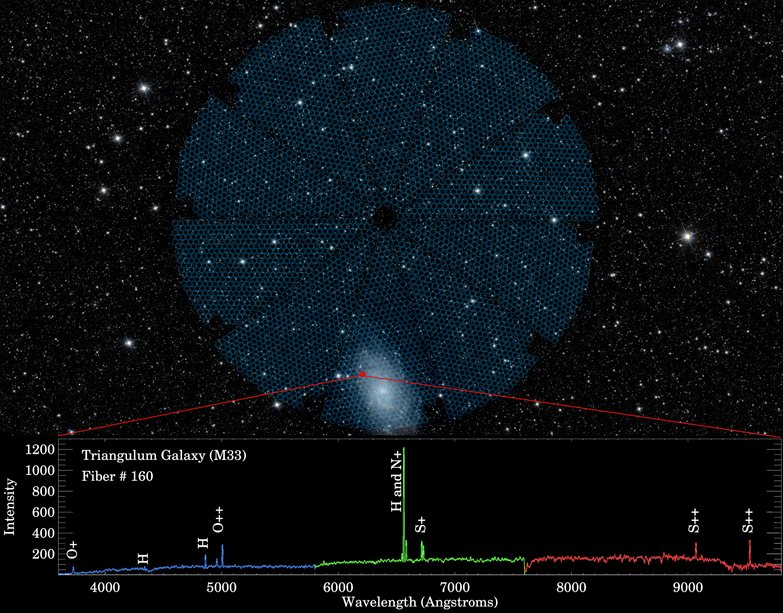Five thousand "eyes" to capture the colors of the cosmos
The Dark Energy Spectroscopic Instrument (DESI), an exceptional instrument to improve the understanding of the role of dark energy in the history of the expansion of the universe, has made its first test observation today, directing its five thousand fiber-optic"eyes" towards the cosmos.
DESI, installed in the Mayall telescope (USA), works with five thousand small robots, each equipped with a fabric-optic cable -about the thickness of a human hair- that picks up the light of a celestial object. These robots are designed to automatically point to a predetermined group of galaxies, capture their light and divide it into several bands of color using a spectrograph, allowing to know precisely the speed with which they move away from us and thus know their distance to Earth. Ideally, DESI can perform these measurements again for a new group of five thousand galaxies every twenty minutes.

The installation of the instrument began in February 2018 at the Nicholas U. Mayall Telescope, located at the Kitt Peak National Observatory (Arizona, USA). Today, with the installation already finished, DESI has carried out its first test. At the beginning of next year the observations will officially begin, which will last for five years. During that period, the new instrument will measure the distance between the Earth and thirty-five million galaxies in an area approximately one third of the sky.
As if it were a powerful time machine, DESI will investigate the first stages of the universe and its early evolution - about eleven billion years ago - to create the most detailed three-dimensional map of the universe to date. In this way, we will know more about dark energy and about the expansion mechanism of the universe. DESI will provide such precise measurements of the speed of this expansion that it will allow to know if it has remained the same or if it has varied over time.
"After a decade of study, research, development, installation and assembly, we are delighted that DESI begins its mission to reveal the mystery of dark energy," says DESI director Michael Levi of the Department of Energy at the Lawrence Berkeley National Laboratory, the institution that leads DESI.
The project has the collaboration of about five hundred researchers assigned to seventy-five institutions in thirteen countries, including Spain.
The Spanish group gathers researchers and engineers from Granada, Madrid and Tenerife, with scientists from the Campus of International Excellence (CEI) UAM + CSIC), specifically Guillermo González de Rivera (Polytechnic School of the UAM), Antonio González Arroyo (Institute of Theoretical Physics) and Francisco Prada (Institute of Astrophysics of Andalusia).

Francisco Prada (IAA-CSIC), principal investigator of the CEI team and member of the Institute of Astrophysics of Andalusia (IAA-CSIC) ensures that “this transdisciplinary technological development has been a milestone, where we have competed at the highest international level and involved Spanish technological companies”.
The CEI has participated in the development of one of DESI's prototypes of robotic fiber optic positioners. The design work required a wide range of engineering disciplines (high precision mechanics, robotics, mechatronics, electronics and control software), which culminated with the testing and verification of the prototype at the Lawrence Berkeley National Laboratory facilities.
“The project was exciting to me from the first moment, it meant accepting a technological challenge of a dimension that you rarely have the possibility to face,” says Guillermo González de Rivera, of the HCTLab research group of EPS-UAM, responsible for the Electronics and control.
The Granada-Madrid-Tenerife (GMT) group that participates in the DESI Collaboration is composed of the CEI UAM + CSIC, the Institute of Astrophysics of Andalusia (CSIC) and the Institute of Astrophysics of the Canary Islands (IAC). The GMT group also worked on the design of the DESI focal plate in close collaboration with the Lawrence Berkeley National Laboratory, and led the construction and characterization of the prototype of one of the ten petals that form the focal plane.
DESI is supported by the U.S. Department of Energy’s Office of Science; the U.S. National Science Foundation, Division of Astronomical Sciences, under contract to the NSF’s National Optical-Infrared Astronomy Research Laboratory; the Science and Technologies Facilities Council of the United Kingdom; the Gordon and Betty Moore Foundation; the Heising-Simons Foundation; the French Alternative Energies and Atomic Energy Commission (CEA); the National Council of Science and Technology of Mexico; the Ministry of Economy of Spain; and DESI member institutions. The DESI scientists are honored to be permitted to conduct astronomical research on Iolkam Du’ag (Kitt Peak), a mountain with particular significance to the Tohono O’odham Nation. View the full list of DESI collaborating institutions, and learn more about DESI, at desi.lbl.gov.
Instituto de Astrofísica de Andalucía (IAA-CSIC)
Unidad de Divulgación y Comunicación
Silbia López de Lacalle - sll[arroba]iaa.es - 958230676
https://www.iaa.csic.es
https://divulgacion.iaa.csic.es

